Space cooling constitutes 15% - 40% of the total energy consumption in a typical commercial building located in hot-arid and hot-humid climates (Itron, Inc., 2006; Eia.gov, 2015). In the USA, a mature air conditioning market, space cooling accounts for around 8% of residential and 13% of commercial elec-tricity consumption and 2% in the EU (IEA, 2010). Many high GDP growth regions of the world fall in cli-mates that require cooling, and the markets there are far from saturation (McNeil & Letschert, 2007). In such a baseline scenario, energy consumption due to air conditioning is only expected to rise signifi-cantly in the coming years, and the search for avenues for efficient cooling mechanisms will become indispensible (GEA, 2012). However, energy-efficient design, components, strengthened by strong poli-cy measures may save 12% (2,105.9 TWh(/yr) of energy on space cooling (including ventilation) in the building sector (IEA, 2011) in the year 2050.
Introduction
Cooling demand in buildings is caused by external as well as internal factors. External factors include solar activity and weather conditions outside. Besides external heat gains, internal factors such as heat gains from people, lighting, various appliances and equipment are responsible for significantly adding to the building’s internal heat gains. Significant cooling load on the buildings can be reduced by following passive building technologies on the building shell, through the use of energy-efficient lighting and appliances and also through optimizing user behaviour and energy management systems. The remaining cooling demand to meet comfort conditions within the space can be met using various cooling technologies as described in this section.
Overview
Various configurations of air conditioning systems are used for space cooling in modern day buildings. The following section gives a brief overview of energy consumption for space cooling in different building sectors.
Residential buildings are mostly served by room air conditioners of different type such as window, split and packaged ducted units etc. There were an estimated 550 to 600 million room air conditioners and ducted air conditioners installed worldwide at the end of 2009 (IEA, 2011). Total sales of all types of Residential air conditioning units (including reversible units) units in 2009 were estimated to be around 55 million (IEA, 2010). The best split units have a COP (kWth/kWel) of around 6 compared to typical units with average sales weighted COP of around 3.5 or less (CLASP, 2011). In simplistic terms this equates to a potential saving of around 40%, although savings in real usage could be more or less than this when seasonal efficiencies and regional variations are taken into account. Cost effective savings for consumers are currently less than this, but better technologies are becoming cheaper as standards are driven up by policies. The IEA estimated global energy consumption by residential air conditioning systems could be reduced by approximately 877 TWh/yr by the year 2050 with stringent policy action when compared to a 2007 baseline scenario (IEA, 2011).
Central air conditioners (typically chillers or multi split Variable Refrigerant Flow/Volume (VRF/VRV)) systems are also sometimes used to cool multiple dwellings in a residential complex or apartment building. However, they meet the cooling needs of a very small proportion of residential buildings, although no reliable estimate is available at the global level. In the United States, only 1.8% of households are served by central air conditioners that meet the needs of two or more residences, while the rest are served by dedicated cooling unit per household.
Central air conditioners are generally used to cool service sector and commercial buildings such as hotels, offices and retail. In commercial buildings robust and complicated cooling systems are used such as chillers and Variable Refrigerant Flow/Volume systems (VRF/VRVs). The smallest systems are essentially large packaged ducted/ductless air conditioners (large splits e.g. VRVs and rooftop units) and can have as little as 10 to 30 kW of capacity. This is a common and cheap solution for small office or commercial buildings. Many small such units can be used to ensure redundancy and that units operate in the optimal range of efficiency.
Chillers are available in a wide range of sizes from 50 kW to as much as 5 MW. The larger chillers are most commonly described by the type of compressor used: scroll, screw and centrifugal. Globally, sales of VRF system packaged units are approximately equal in value to sales of chillers, although the much of the cost of a central system is for installation of pipes or ducts. Ducted air systems are less widely used than VRF/multi-split systems due to the need for bulky ducts throughout the building. In Europe, ducted splits, single splits and multi splits account for around 21% of the market for larger cooling systems (including for the commercial sector), VRF systems account for 14% and chillers account for about 59% (ARMINES, NHK, BRE 2011).
Overall savings potential due to the use of BAT is in the range 35% to 50% for individual cooling systems, with an incremental installed cost of 25% to 75%. IEA (2011) estimates an energy savings of approximately 1,228.4 TWh/yr by 2050 by following best practices in space cooling compared to a typical 2007 baseline scenario. This has the advantage of being able to utilize potentially more efficient, centralized plant, while also reducing external clutter and noise around the building caused due to individual AC units. The trade off is typically in terms of the space and cost of the plant room, piping and ducting and greater cooling distribution losses compared to small residential systems.
Market
The market value of refrigeration in 2010 was worth €46 billion (US$63 billion) and rose to about €64.3 billion ($88.4 billion) in 2012 (BSRIA, 2012). Packaged equipment for residential and commercial use accounts for two thirds of that value. The remainder is from commercial equipment for central systems, including chillers, rooftop units, VRF (variable refrigerant flow) systems, rooftop units and fan coil units (BSRIA, 2012).
The following figures show worldwide distribution of refrigeration market in 2012 by both market value and by market volume. While China leads the world market in both categories, USA follows China in total number of units while Japan follows China in total market value. It has to be noted that while USA and Japan almost reached market saturation, many other countries, with their low share of value, represent high growth markets (McNeil & Letschert, 2007; BSRIA, 2012).
Value of the global air conditioner market, by country, in billions of Euro
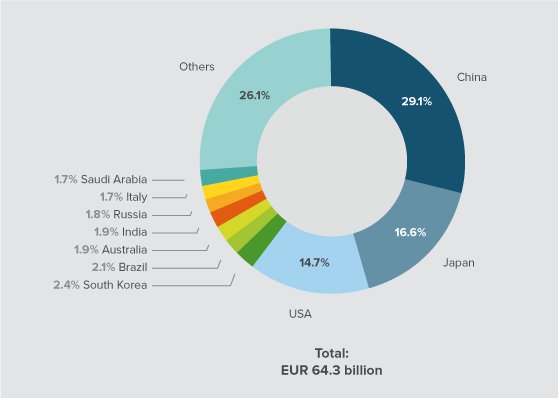
Source: BSRIA, 2013
Volume of the global air conditioner market, by country, in millions of unitsLookup
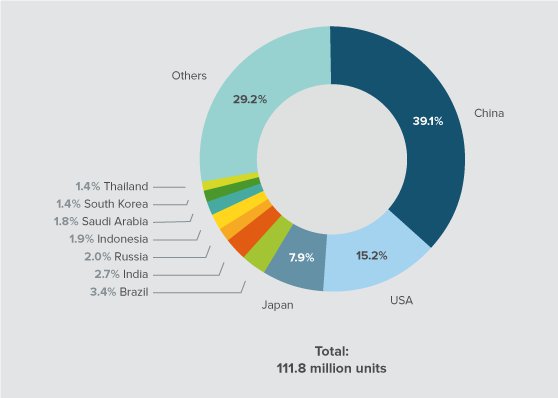
Source: BSRIA, 2013
Unducted split systems dominate space cooling market with little over half by value and by almost 70% by volume. Window units account for 3.5%; US style ducted systems account for 6.5%. High efficient systems such as VRF and Chillers account for 9.2% and 9.4% respectively. However, it is to be noted that the volume of these systems is very miniscule compared to other systems, i.e., VRF accounts to only 0.8% and Chiller account to only 0.3% of total units by number. This is because of their application which suits only in large and high rise buildings. Ducted central systems account for over half the market in the USA, Canada and Australia. China is by far the most significant market for air conditioning globally (BSRIA, 2012).
Value of the global air conditioner market, by product type, in billions of Euro
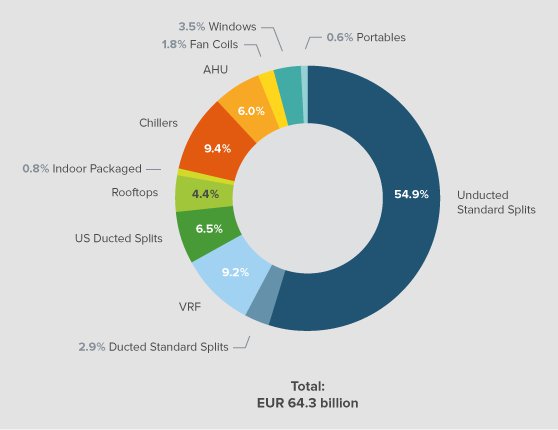
Source: BSRIA, 2013
Volume of global air conditioner market, by product type, in millions of units
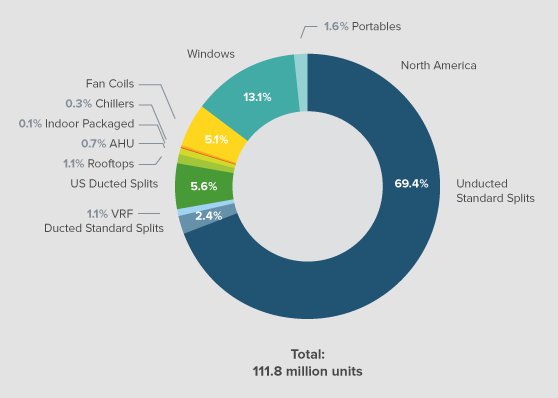
Source: BSRIA, 2013
In saturated markets like that of the US and Japan, the demand for air conditioning is driven by factors such as replacement of older refrigerants with newer, less harmful ones; the need for improving the efficiency standards of existing stock; increase in technology such as smart homes etc. In emerging markets the demand is driven by the rapid construction of new buildings with the need to air conditioning. Here, priority for harmless refrigerants and demand for efficient equipment often take a back seat. This is where policy driven market becomes indispensible to keep a check on energy usage and other related environment issues.
Technology
There are two basic methods of space cooling technology available for commercial and residential air conditioning equipment in buildings. One method is the ‘vapour compression refrigeration cycle’. The second method is based on the ‘vapour sorption/desorption technique’. While the vapour compression cycle is driven by electricity, sorption/desorption cooling uses heat, which can also be solar heat as primary source of energy. The following list thereafter gives more information on various kinds of cooling equipment and cooling distribution systems available.
Comparison of COP (typical average Vs. highest efficiency: BAT) of various types of cooling equipment
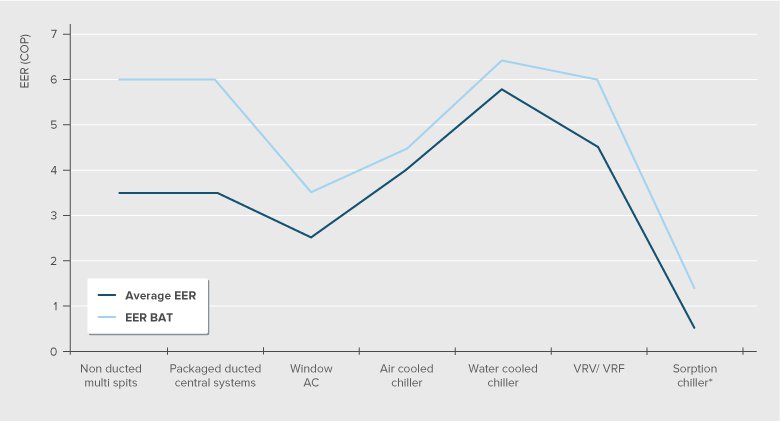
Source: Data from various product catalogues and ARMINES, VHK, BRE (2012) study
Note: The higher the COP, the more energy-efficient is a technology. The COP of a sorption chiller appears low but it can use free heat (such as waste heat, solar energy). All other technologies require electricity, which requires primary energy input of at least a factor 2.5 higher to generate.
A distributed CHCP system is the provision of space heating and cooling, as well as sanitary hot water. A distributed CHCP system is located in or on the site of a building. The system consists of an electrical prime mover that generates electricity, with a heat recovery system, a thermally driven chiller and a heat rejection system. These are the minimum components of a CHCP, but they will usually include a hot water storage tank and cold water storage tank to help manage the system. A conventional boiler and air conditioner can be incorporated into the system to meet peak demand or for back-up in larger multi-family dwellings.
District cooling is the provision of space cooling needs through the distribution of cold water through a distribution grid to individual buildings. Cold is generated at a single or multiple central locations and can be delivered directly into the building, or through heat exchangers at the building. The centralised production of cold at a large-scale, perhaps in a number of different locations in the network to reduce distribution losses, allows the design of highly efficient systems using the latest cooling technologies. The distribution network for district cooling is essentially the same as for a district heating network, and indeed some studies have looked at the feasibility of using district heating networks in summer as cooling networks. Significant energy is required for pumping, around 1% of the cooling energy supplied may be typical, but given district cooling systems tend to be small a lower value may be achievable. At the same time, distribution losses can be significant. However, in temperate climates, if insulated pipes can be buried, ground temperatures won’t be significantly different from the supply distribution temperature. However, where it is too expensive to underground much of the network, or in hot climates, losses can be more significant and may be in the order of 2-10%.
Similar to DX AC units, electric chillers also use ‘refrigerant vapour compression/expansion cycle’. However, chillers vary from vapour compression units in the way they exchange heat with the space. ‘Evaporator’ unit in a chiller exchanges heat with water to produce chilled water. This chilled water is then circulated throughout the building using pipes. The chilled water pipes are connected to either Air Handling Units (AHU) or special zone terminal equipment from where the heat exchange takes place between the chilled water and the space through convection or radiation.
Chillers account for approximately 9.4% of the total cooling market by value (BSRIA, 2013). Energy cost of operating chillers could be in the range of 50-90% of total life cycle costs. Overall energy savings potential by using BAT chiller against average chiller is in the range of 10% to 30% annually. The incremental capital cost of using BAT chiller ranges from 25% within the chillers of the same kind (e.g., screw chiller Vs BAT screw chiller) to as high as 75% within chillers of difference categories (e.g., air cooled screw chiller Vs water cooled centrifugal chiller).
Thermally driven chillers use “Vapour Absorption/Adsorption” principle to produce cooling. Vapour pressure and temperature of the refrigerant is raised using desorption (from a desiccant absorbent or adsorbent) instead of using electric compressors like in the “vapour compression cycle”. Heat energy used for this process, is obtained by either using direct-fired sources or by using reclaimed waste heat from sources such as Combined Heating, Cooling and Power systems (CHCP) etc. Similar to electric chillers, thermally driven chillers also produce chilled water that is then used to cool the space.
DX (Direct Expansion) Air-Conditioners (AC) use ‘refrigerant vapour compression/expansion cycle’ to produce cooling (in other terms, to remove heat from the space). The heat is removed from the space through natural or forced convection by an ‘evaporator’ unit that is usually located within the space (packaged units however, use ducts and big fans). The heat removed from the space is rejected to the outside atmosphere through a ‘condenser’. Various configurations of DX units are in use such as window AC, split AC, heat pumps, Variable Refrigerant Volume/Flow (VRV/VRF) AC and also packaged ducted units.
There were an estimated 550 to 600 million DX units in the form of room air conditioners and packaged ducted air conditioners installed worldwide at the end of 2009 (IEA, 2011). Annual sales of these air conditioners were around 55 million (including reversible units) in 2009 (IEA, 2010). The best split units have a COP of around 6 compared to average sales weighted efficiencies of around 3.5 or less. In simplistic terms this equates to a potential energy saving of around 40%, although savings in real usage could be more or less than this when seasonal efficiencies and regional variations are taken into account.
Improvements
Each of the key components of air conditioners have technology solutions that can significantly improve the efficiency compared to average typical units. In some markets most, or all of these, are necessary features to achieve the local regulatory minimum energy performance standards (MEPS) (e.g. in Japan) and are typically seen in high efficiency products in many other markets. Each technology is summarised below and in the following table, along with the indicative energy savings they can achieve if applied on their own to a basic low efficiency unit. Note that the different technologies interact and savings overlap, so savings from each cannot be added together to estimate overall potential.
The following table summarises various energy efficiency improvements manufacturers can apply in vapour compression based air conditioners.
Summary of savings measures for room DX conditioners
| Measure |
Comments |
Indicative savings range (%) |
| Compressor |
Inverter control, matching speed to cooling demand |
30% (up to 50% in some applications) |
| Compressor |
DC drive motor; better compressor |
Up to 15% |
| Dedicated dehumidifier |
Use dedicated dehumidifier or two stage compressors |
20-40% depending upon the humidity levels |
| Improved heat exchangers |
Larger/improved condenser and evaporator |
Up to 25% |
| Improved expansion valve |
Electronically controlled |
9% |
| Improved expansion valve |
Thermostatically controlled |
5% |
| Variable speed inverter driven fans |
For evaporator and condenser fans |
4% |
| Reduced standby (electronics) |
Savings are higher in temperate climates (less usage) and for smaller units |
3% for average systems |
| Reduced standby (crank case heater) |
Only applicable in 10% of units for cold weather usage (often reversible units). Savings higher % for temperate climates (less usage) |
Some units: Up to 50% in cold weather climates |
Adapted from Armines, 2009
The following table summarises various energy efficiency improvements manufacturers can apply in chillers.
Summary of savings measures for Chillers
| Component |
Comments/Improvement measures |
Indicative savings range (%) |
| Compressor |
For systems over 200 kW BAT is oil-free centrifugal compressor with magnetic levitation bearings |
30% to 50% |
| Compressor |
Variable speed inverter control, matching speed to cooling demand |
30% (up to 50% in some applications) |
| Heat recovery condensers |
Employ special heat exchanger to use waste heat rejected from chillers for useful heating purposes |
- |
| Improved heat exchangers |
Improved design evaporator, e.g., by microchannel type system |
10% |
| Evaporative coolers / Water cooled condensers |
Consumes water and require maintenance for health protection, However, significant energy savings are obtained in most applications |
15% to 25% |
| Improved and inverter driven (variable speed) condenser fans |
Most efficient solutions will have larger fans and variable speed drive to closely match flow with cooling demand |
Typically 5% but can be more |
| Improved expansion valve |
Electronically controlled |
9% |
Authors
Michael Taylor
Sriraj Gokarakonda
Christopher Moore
References
- ARMINES, VHK, BRE, (2012). Final report of Task 2 - Air-conditioning products July 2012. Sustainable Industrial Policy – Building on the Ecodesign Directive – Energy-Using Product Group Analysis/2 - Lot 6: Air-conditioning systems. [online] DG ENERGY European Commission. Available at: http://www.ecohvac.eu/downloads/Task%202%20Lot%206%20Air%20Conditioning%20Final%20report%20July%202012.pdf [Accessed 9 Feb. 2012].
- BRISA, (2012). Published multi-client market research reports. [online] Available at: https://www.bsria.co.uk/market-intelligence/market-reports/ [Accessed 12 Feb. 2013].
- BRISA, (2013). HVACR 2013 - Analysing world markets. [online] De.slideshare.net. Available at: http://de.slideshare.net/BSRIA/hvacr-2013-analysing-world-markets [Accessed 14 Feb. 2013].
- CLASP, (2011). Cooling benchmarking study report. [online] The Collaborative Labelling and Appliance Standards Program. Available at: http://clasp.ngo/~/media/Files/SLDocuments/2012/CoolingBenchmarkingStudy/RAC%20benchmarking%20-%20Report.pdf [Accessed 2 Nov. 2015].
- Eia.gov, (2015). Energy Information Administration (EIA)- About the Commercial Buildings Energy Consumption Survey (CBECS). [online] Available at: http://www.eia.gov/consumption/commercial/about.cfm [Accessed 28 Jun. 2015].
- GEA, (2012). Global Energy Assessment - Toward a Sustainable Future. [online] Laxenburg: International Institute for Applied Systems Analysis 2012. Available at: http://www.iiasa.ac.at/web/home/research/Flagship-Projects/Global-Energy-Assessment/GEA-Summary-web.pdf [Accessed 2 Apr. 2013].
- IEA, (2010). ENERGY TECHNOLOGY PERSPECTIVES 2010 - Scenarios & Strategies to 2050. [online] Paris Cedex: International Energy Agency. Available at: https://www.iea.org/publications/freepublications/publication/etp2010.pdf [Accessed 2 Nov. 2012].
- IEA, (2011). Technology Roadmap. Energy-efficient Buildings: Heating and Cooling Equipment. [online] Paris Cedex: International Energy Agency. Available at: https://www.iea.org/publications/freepublications/publication/buildings_roadmap.pdf [Accessed 2 Mar. 2013].
- Itron, Inc., (2006). California Commercial End-Use Survey Report. [online] California: California Energy Commis-sion. Available at: https://www.google.de/search?q=CALIFORNIA+COMMERCIAL+END-USE+SURVEY&ie=utf-8&oe=utf-8&gws_rd=cr&ei=z403Vq6yMYfxUqWDqPAH [Accessed 2 Feb. 2013].
- McNeil, M. and Letschert, V. (2007). Future air conditioning energy consumption in developing countries and what can be done about it: the potential of effi ciency in the residential sector. In: eceee 2007 Summer Study. [online] Stockholm: ECEEE, pp.1311-1322. Available at: http://www.eceee.org/library/conference_proceedings/eceee_Summer_Studies/2007/Panel_6/6.306/paper [Accessed 2 Nov. 2012].
